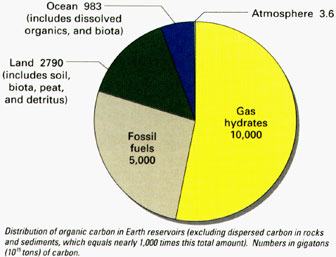New potential fuel source carries global warming risk
New potential fuel source carries global warming risk
mongabay.com
August 21, 2006
Scientists supported by the Integrated Ocean Drilling Program, an international marine research program that explores sea floor sediments and rocks, announced that they found deposits of methane gas hydrates at considerably less depth than expected. The discovery, published in the August. 15, 2006 edition of the American Geophysical Union’s EOS may have implications for future energy use as well as climate change.
“We found anomalous occurrences of high concentrations of gas hydrate at relatively shallow depths, 50-120 meters below the seafloor.” said Michael Riedel of McGill University, Montreal, who was the co-chief of the IODP expedition.
The finding is significant because it means that this potential energy source is more accessible than previously believed, presenting the possibility that it could be developed as other fossil fuel sources are diminished in the future. Further, the close proximity of gas hydrate deposits to the seafloor could mean that they are less stable and more susceptible to melting than thought, increasing the risk that massive amounts of methane could be released into the atmosphere ocean temperatures rise significantly.
 Hydrates store immense amounts of methane, with major implications for energy resources and climate, but the natural controls on hydrates and their impacts on the environment are very poorly understood. Gas hydrates occur abundantly in nature, both in Arctic regions and in marine sediments. Gas hydrate is a crystalline solid consisting of gas molecules, usually methane, each surrounded by a cage of water molecules. It looks very much like water ice. Methane hydrate is stable in ocean floor sediments at water depths greater than 300 meters, and where it occurs, it is known to cement loose sediments in a surface layer several hundred meters thick. The worldwide amounts of carbon bound in gas hydrates is conservatively estimated to total twice the amount of carbon to be found in all known fossil fuels on Earth. This estimate is made with minimal information from U.S. Geological Survey (USGS) and other studies. Extraction of methane from hydrates could provide an enormous energy and petroleum feedstock resource. Additionally, conventional gas resources appear to be trapped beneath methane hydrate layers in ocean sediments. IMAGE AND CAPTION TEXT COURTESY OF USGS |
Gas hydrates — solid methane ice deposits at the bottom of the ocean and in terrestrial permafrost — are only stable only under low temperature and relatively high pressure and some scientists believe that the deposits may have played an important role in past episodes of rapid climate change by causing fluctuations in atmospheric concentrations of greenhouse gases.
One hypothesis, called the “Clathrate Gun” hypothesis, developed by James Kennett, professor of geological sciences at the University of California at Santa Barbara (UCSB) proposes that past climate shifts were caused by a massive decomposition of the marine methane hydrate deposits.
“According to Kennett’s hypothesis, climatic destabilization would cause a sharp increase in atmospheric methane —— thereby initiating a feedback cycle of abrupt atmospheric warming,” states a recent news release from UCSB. “This process may threaten the current climate [since] according to the researchers,,, [w]armer ocean temperatures from current global climate change is likely to release methane currently trapped in vast hydrate deposits on the continental shelves.”
The rapid decomposition of frozen methane hydrate deposits may have been responsible for the sharp spike in atmospheric concentrations of greenhouse gases during the Palaeocene/Eocene thermal maximum (PETM) — a period of rapid, extreme global warming about 55 million years ago. The methane released during melting would have reacted with oxygen to produce huge amounts of carbon dioxide, also a potent greenhouse gas. The warming caused a mass extinction among marine animals and helped usher in the “Age of Mammals.”
Beyond the rapid decomposition of methane hydrates due to warmer temperatures, some researchers have expressed concern over proposals to use methane hydrate deposits as an energy source. Methane, better known as natural gas, is viewed by some as the potential replacement for petroleum. According to the U.S. Geological Survey, anywhere from 100,000 to 300 million trillion cubic feet of methane exists globally in hydrate deposits. Perhaps 200,000 trillion cubic feet of these lie within U.S. coastal waters — enough potential energy to fuel the country for centuries. The problem is that in the atmosphere, methane is 21 times more potent than carbon dioxide as a greenhouse gas. The exploitation of methane hydrate deposits could further drive global warming through carbon dioxide emissions resulting from increased burning of the fossil fuel as well as direct releases of the gas into the atmosphere.
“The destabilization of gas hydrates is likely to be a serious hazard in the near future due to the effects of global warming,” warned Dr. Mark Maslin, a geographer at University College London and a senior researcher for the London Environmental Change Research Center, in a paper presented at the Annual Conference of the Royal Geographical Society last year. “Research already exists to suggest that the release of hydrates increased global temperature 18,000 years ago, and we now face a similar threat as our global temperature continues to rise.”
This article used quotes and information from USGS, the Integrated Ocean Drilling Program (“Frozen” Natural Gas Discovered at Unexpectedly Shallow Depths Below Seafloor”), the University of California at Santa Barbara (“Ocean floor gas may fuel global warming”), and previous mongabay.com articles.